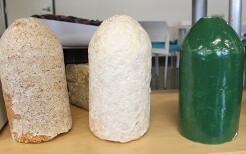Everyone knows that microplastics are a problem in the ocean and that commercial fishing gear contributes to the problem. Sue Van Hook and the team at Ecovative Design in New York have developed a biodegradable buoy made of mushrooms—the Myco-Buoy—that may replace the styrofoam buoys lobstermen currently use.
“I grew up on North Haven,” says Van Hook. “My grandfather was a lobsterman, and he turned his own wooden buoys on a lathe. All of us kids would help paint them.” According to Van Hook, lobstermen in Maine report losing anywhere from 5 to 30 percent of their gear—including styrofoam buoys—each season, depending on their location, with losses higher in southern Maine and lowest Downeast. “That’s a lot of plastic,” says Van Hook.
Though she was not actively seeking a solution to the lobster buoy problem, Van Hook made a discovery in 2011.
“I was working with mycelium [the network of fungal threads from which mushrooms grow], and I noticed the water was beading on it,” she says. “We played with it some more and found that mycelium floats. We made some ducks out of it that we started to give away, and then I thought about lobsterbuoys. We took some 2-liter soda bottles and grew mycelium buoys in them.”
Wasting no time, Van Hook presented the buoys at a Maine Department of Marine Resources (DMR) Lobster Advisory Council meeting that same year. “The thing is that the buoys, uncoated, only last five months. The Advisory Council was very interested but asked us to find a way to make the buoys last at least a year.”

Van Hook presented the buoys at another meeting and found that younger lobstermen were interested. “They like the idea. We challenged them and several high schools to help us find a coating that would protect the mycelium and resist the impacts a lobster buoy endures.” But Van Hook retired before those problems could be solved.
Now she’s back.
“I got a call from a colleague in Japan who had developed a soy-based coating, and at nearly the same time, I got a call from a Downeast seaweed farmer who wanted to get away from plastics.”
The concurrence of these calls brought Van Hook out of retirement. Now she is actively working on buoys for oyster and seaweed farmers, while re-engaging with the challenge of finding a coating that will stand up to the rigors of lobster fishing, and make Myco-Buoys suitable for the industry.







